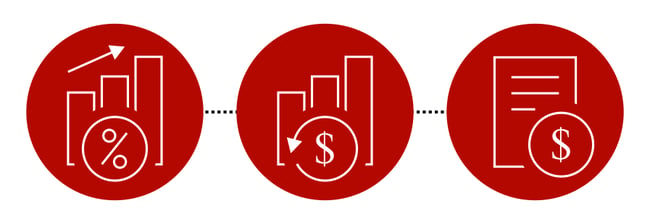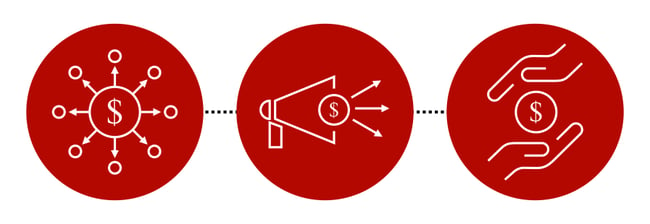It’s not difficult to sympathise with you if you’re a supplier attempting to negotiate shelf space for your products. After all, like other suppliers, you’ll often find yourself up against experienced retailers who have created different fees (and terms) to help them build their margin. You need to understand them all. Because, if you don’t, you could undermine yourself before talks begin.
But don’t let that overwhelm you.
As much as there are many different negotiations terms and fees that you should know, you can learn them. Most importantly, you can understand them so that the next time you enter a meeting with a buyer where you want to negotiate for space to increase your retail sales, you’re well prepared.

1. Trade discounts
The first negotiation term to know and understand is trade discounts.
A trade discount is essentially a percentage discount on the list price that you’d give a retailer when they buy above a certain quantity of goods from you. That is also why you will often hear it referred to as volume-based pricing or volume-based discounts.
Let’s say, for example, that you’re a Coffee supplier who provides products to various retailers. If a retailer approaches you and orders in bulk, you could offer them a discount in return. Besides the obvious benefit to them - it saves the retailer money - it also allows you to strengthen any relationship you have with them.
Of course, there does need to be some form of trust for this to work. If the retailer promises to buy a certain amount of product only to decide at the last minute to cancel or reduce their order, that damages the supplier-retailer relationship. The same will happen if you quote a price for X amount of product, the retailer pays for it, but you end up underdelivering.
As a supplier, you can also incentivise the retailer with a percentage rebate for any pre-defined growth hurdle targets. In this instance, if the retailer purchases the same amount of product or has increased their spending over an extended period - showing you that there is an appropriate return on investment for you to continue supplying them - you could offer them a rebate.
2. Trade rebates
The second negotiation term - trade rebate - is similar to the first. That’s because it acts as a form of discount to encourage you to list your products on the shelf. However, unlike the discount, which is immediate, a rebate is paid out over a set period.
There are different understandings of what a trade rebate is, depending on how you approach it. In marketing, it’s a type of sales promotion used as an incentive. In the context of retail, a trade rebate is a fee that you would pay a retailer to receive an initial listing for your product in their store. This is usually for a new product line with little to no retail sales data.
Besides that, this fee could also take the form of a percentage of your total order to place your products on their shelf.
Improve your shelf inventory replenishment efficiency with DotActiv software
As for why retailers use this to build their margin, that’s straightforward. These fees serve to allocate scarce retail shelf space efficiently. More than that, they help balance the risk of new product failures between yourself and them. In other words, it’s a fail-safe to ensure that they don’t suffer any unforeseen consequences alone, such as carrying the cost of holding inventory that doesn’t sell as projected.
Since shelf space is one of their most valuable assets, there shouldn’t be any room for criticism. Retailers need to be strategic in how they use their shelf space, and they can’t allow just any product to fill it.
3. Payment terms
When negotiating shelf space for your products, talks will invariably turn to payment terms. Now, there doesn’t need to be too much explanation around the definition of payment terms since it’s relatively simple to understand. It’s the conditions under which a seller would complete a sale.
That said, there are many different terms to consider. And they all depend on how the retailer prefers to do business with their suppliers.
For example, they may decide to pay you upfront before listing your products on their shelves. Alternatively, they could offer you cash on the delivery of your products. If they can’t pay for the goods, they’ll return them to you. Another popular method is to defer the payment over a chosen period. These periods can be anywhere between 30, 60 or 90 days depending on the deal you’ve negotiated with the retailer.
Regardless of which payment term you decide on, they help the retailer to build their cash flow. That’s because once goods are sold, the retailer usually banks that money and in doing so can either earn interest on it or invest it in purchasing additional stock. Then, if they’ve been smart with their investment, when the time comes for them to pay you, they can do that knowing full well that they’ve increased their profit margin.
For you and other suppliers, it’s just as important to understand the payment terms. After all, the last thing you’d want is to sign a contract only to find out afterwards that they are paying you later than you had expected. That can have disastrous effects on your cash flow and could even cripple your business.

4. Distribution fees
In the new supply chain era where everything is increasingly integrated, the distribution centre model has become a dominant standard. That makes sense if you consider that it’s a centralised form of distribution where the retailer has full control. Meanwhile, direct store deliveries, either by yourself or by third-party logistics service providers are on the decline.
Of course, it does depend on the size of the retailer that you supply. Not all will have distribution centres. In those cases where they don’t, direct store delivery remains the logical distribution route. However, if you want to have an opportunity of listing your products in large retailers, you need to factor distribution fees into your overall expenses.
When considering these fees, there are two specific ones that a retailer usually includes. The first is a distribution centre allowance to the warehouse. It is typically a price reduction that you would offer a retailer to process your goods at the distribution centre.
The second fee revolves around a distribution allowance, and it’s done to cover the cost of distributing your products to stores. There is no set fee for either - it depends mainly on the discretion of the retailer and the deal you sign with them.
Of course, when negotiating with retail buyers, you do need to be satisfied with the final fees. You must ensure that what they’re asking you to pay is less than what you would have paid if you had approached a third party to distribute your goods or if you had decided to distribute your products yourself.
5. Promotional spend
As much as getting your products into a store is a moment to celebrate, you also need to understand that that doesn’t guarantee you any retail sales. You must promote them too.
In most instances, the retailer will ask you to contribute financially to these efforts. That makes sense if you consider how many products and categories any one retailer stocks. They can’t cover promotional costs for every product.
Fortunately, this is where your promotional spend comes in.
Also known as a promotional budget, it is the allowance that you offer to retailers in exchange for advertising your products in their store. These budgets are created to anticipate the essential costs associated with growing a business. Also, if you want to ensure that a retailer pushes your products correctly, advertising is a sure way.
Maximise the selling potential of your shelf space with DotActiv software
As for the details of this allowance, it could either be a percentage of your turnover, an annual value, per promotion or purchase of promotional space.
For your promotion to be genuinely useful in-store and to stand a better chance of persuading a retailer to promote your brand, you do need to align yourself with the retailer. That includes looking at how your promotion benefits them and helps them reach their goals.
But it will be worth it. By knowing about promotional spending, factoring it into your expenses and then using it appropriately, you can ensure that you receive fair advertising exposure. More importantly, you can ensure that you have access to a promotional space where you can push your products.
6. Settlement discount
While trade discounts are deductions that you offer retailers off of your list or catalogue price, settlement discounts are intended to speed up the payment process.
By offering this discount, also labelled as Prompt Payment Discounts, you’re paving the way to increase your cash flow.
Let’s say, for example, that you’ve agreed to a 30-day payment term with a retailer. As part of this agreement, you have added a clause that states that if the retailer pays within the first 10 to 15 days, you will offer them a 2% discount. Considering retail margins and the constant drive to look after their bottom line, you may find many retailers jumping at that opportunity.
And, while they will save money, you’re able to remain liquid too. That’s especially pertinent to you if you’re a small supplier since cash flow is one of the biggest reasons why small businesses fail. If you offer a settlement discount to all the retailers that you do business with, and they meet that deadline consistently, you shouldn’t concern yourself with the rebate or consider dropping it. After all, you’re ensuring that there is a consistent flow of cash into your business.
Manage the rest of your supply business just right, and you could soon see yourself expanding your operations. Nonetheless, you do need to ensure that this is the most cost-effective way for you to fund your cash flow. If, for example, you’re not experiencing any significant cash flow problems, you may not have to offer a settlement discount in the first place.
Conclusion
Looking to get more shelf space for your products in-store? Or, need advice on how to negotiate with and persuade a retailer to take on your promotions? Book a custom exploratory consultation with a DotActiv expert here or browse our online store here.


